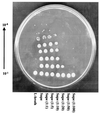A protease-resistant catalase, KatA, released upon cell lysis during stationary phase is essential for aerobic survival of a Pseudomonas aeruginosa oxyR mutant at low cell densities
- PMID: 10913089
- PMCID: PMC94627
- DOI: 10.1128/JB.182.16.4557-4563.2000
A protease-resistant catalase, KatA, released upon cell lysis during stationary phase is essential for aerobic survival of a Pseudomonas aeruginosa oxyR mutant at low cell densities
Abstract
A Pseudomonas aeruginosa oxyR mutant was dramatically sensitive to H(2)O(2), despite possessing wild-type catalase activity. Oxygen-dependent oxyR phenotypes also included an inability to survive aerobic serial dilution in Luria broth and to resist aminoglycosides. Plating the oxyR mutant after serial dilution in its own spent culture supernatant, which contained the major catalase KatA, or under anaerobic conditions allowed for survival. KatA was resistant to sodium dodecyl sulfate, proteinase K, pepsin, trypsin, chymotrypsin and the neutrophil protease cathepsin G. When provided in trans and expressed constitutively, the OxyR-regulated genes katB, ahpB, and ahpCF could not restore both the serial dilution defect and H(2)O(2) resistance; only oxyR itself could do so. The aerobic dilution defect could be complemented, in part, by only ahpB and ahpCF, suggesting that the latter gene products could possess a catalase-like activity. Aerobic Luria broth was found to generate approximately 1.2 microM H(2)O(2) min(-1) via autoxidation, a level sufficient to kill serially diluted oxyR and oxyR katA bacteria and explain the molecular mechanism behind the aerobic serial dilution defect. Taken together, our results indicate that inactivation of OxyR renders P. aeruginosa exquisitely sensitive to both H(2)O(2) and aminoglycosides, which are clinically and environmentally important antimicrobials.
Figures




Similar articles
-
Role of the Pseudomonas aeruginosa oxyR-recG operon in oxidative stress defense and DNA repair: OxyR-dependent regulation of katB-ankB, ahpB, and ahpC-ahpF.J Bacteriol. 2000 Aug;182(16):4533-44. doi: 10.1128/JB.182.16.4533-4544.2000. J Bacteriol. 2000. PMID: 10913087 Free PMC article.
-
The peptidoglycan-associated lipoprotein OprL helps protect a Pseudomonas aeruginosa mutant devoid of the transactivator OxyR from hydrogen peroxide-mediated killing during planktonic and biofilm culture.J Bacteriol. 2008 May;190(10):3658-69. doi: 10.1128/JB.00022-08. Epub 2008 Feb 29. J Bacteriol. 2008. PMID: 18310335 Free PMC article.
-
The major catalase gene (katA) of Pseudomonas aeruginosa PA14 is under both positive and negative control of the global transactivator OxyR in response to hydrogen peroxide.J Bacteriol. 2010 Jan;192(2):381-90. doi: 10.1128/JB.00980-09. Epub 2009 Nov 20. J Bacteriol. 2010. PMID: 19933365 Free PMC article.
-
Cellular and molecular physiology of Escherichia coli in the adaptation to aerobic environments.J Biochem. 1996 Dec;120(6):1055-63. doi: 10.1093/oxfordjournals.jbchem.a021519. J Biochem. 1996. PMID: 9010748 Review.
-
OxyR: a regulator of antioxidant genes.J Nutr. 1992 Mar;122(3 Suppl):627-30. doi: 10.1093/jn/122.suppl_3.627. J Nutr. 1992. PMID: 1542022 Review.
Cited by
-
Epidemiology and Characteristics of Elizabethkingia spp. Infections in Southeast Asia.Microorganisms. 2022 Apr 22;10(5):882. doi: 10.3390/microorganisms10050882. Microorganisms. 2022. PMID: 35630327 Free PMC article. Review.
-
Role of the Pseudomonas aeruginosa oxyR-recG operon in oxidative stress defense and DNA repair: OxyR-dependent regulation of katB-ankB, ahpB, and ahpC-ahpF.J Bacteriol. 2000 Aug;182(16):4533-44. doi: 10.1128/JB.182.16.4533-4544.2000. J Bacteriol. 2000. PMID: 10913087 Free PMC article.
-
Draft genome sequence of novel Candidatus Ornithobacterium hominis carrying antimicrobial resistance genes in Egypt.BMC Microbiol. 2024 Feb 2;24(1):47. doi: 10.1186/s12866-023-03172-6. BMC Microbiol. 2024. PMID: 38302869 Free PMC article.
-
Genetic and physiological characterization of ohr, encoding a protein involved in organic hydroperoxide resistance in Pseudomonas aeruginosa.J Bacteriol. 2001 Jan;183(2):773-8. doi: 10.1128/JB.183.2.773-778.2001. J Bacteriol. 2001. PMID: 11133975 Free PMC article.
-
AnkB, a periplasmic ankyrin-like protein in Pseudomonas aeruginosa, is required for optimal catalase B (KatB) activity and resistance to hydrogen peroxide.J Bacteriol. 2000 Aug;182(16):4545-56. doi: 10.1128/JB.182.16.4545-4556.2000. J Bacteriol. 2000. PMID: 10913088 Free PMC article.
References
-
- Altuvia S, Almirón M, Huisman G, Kolter R, Storz G. The dps promoter is activated by OxyR during growth and by IHF and ςS in stationary phase. Mol Microbiol. 1994;13:265–272. - PubMed
-
- Beers R F, Jr, Sizer I W. A spectrophotometric method for measuring the breakdown of hydrogen peroxide by catalase. J Biol Chem. 1952;195:133–140. - PubMed
-
- Bradford M M. A rapid and sensitive method for the quantitation of microgram quantities of protein utilizing the principle of protein-dye binding. Anal Biochem. 1976;72:248–254. - PubMed
-
- Brown S M, Howell M L, Vasil M L, Anderson A J, Hassett D J. Cloning and characterization of the katB gene of Pseudomonas aeruginosa encoding a hydrogen peroxide-inducible catalase: purification of KatB, cellular localization, and demonstration that it is essential for optimal resistance to hydrogen peroxide. J Bacteriol. 1995;177:6536–6544. - PMC - PubMed
-
- Christman M F, Morgan R, Jacobson F S, Ames B N. Positive control of a regulon for defenses against oxidative stress and some heat-shock proteins in Salmonella typhimurium. Cell. 1985;41:753–762. - PubMed
Publication types
MeSH terms
Substances
Grants and funding
LinkOut - more resources
Full Text Sources
Miscellaneous

